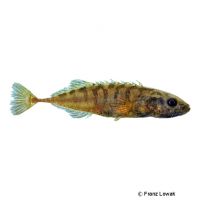Ninespine Stickleback (Pungitius pungitius)
| Ninespine Stickleback Pungitius pungitius | |
|---|---|
| Name | Ninespine Stickleback |
| Name Lat. | Pungitius pungitius |
| Family | Sticklebacks |
| Family lat. | Gasterosteidae |
| Order | Perch-likes |
| Order lat. | Perciformes |
| Origin | Europe, Asia, North America |
| Habitat | Estuaries, rivers |
| Diet | Carnivore |
| pH | 7.5-9.5 |
| Behavior | Semi-aggressive |
| Keeping | Individual, group |
| Care Level | Moderate |
| Reproduction | Nest builder |
| Breeding | Moderately difficult |
| Life Span | 3-5 years |
| Protection | No |
| Metric Units | |
| Size | 5-7 cm |
| Temperature | 4-22 °C |
| Hardness | 2-15 °dH |
| Aquarium | 100 l or ponds |
| US Units | |
| Size | 2"-2.8" |
| Temperature | 39-72 °F |
| Hardness | 36-267 ppm |
| Aquarium | 25 gal or ponds |
Distribution and habitat
The nine-spined stickleback is widely distributed in marine, brackish and freshwater in the temperate latitudes of the northern hemisphere and has produced several subspecies as well as site variants. They live in plant-rich shallow water zones of slow-flowing waters as well as in ponds and pools.
Maintenance
The pond should be furnished with pond, floating and especially oxygenating underwater plants (milfoil, waterweed, hornwort, etc.), large river pebbles, and a substrate of sand and round-grained gravel, and provide plenty of free swimming space.
When caring for the fish in the aquarium (from 100 l), it is important to ensure that, in addition to dense marginal planting and numerous hiding places (roots, stones), there is also sufficient swimming space available. A soft substrate covered with some fallen leaves (e.g. beech leaves), oxygen-rich water and slightly shaded light (floating plants) is ideal
No ammonia, ammonium and nitrite should be detectable, the nitrate value should not exceed 100 mg/l. To ensure the water quality and oxygen content should not be missing a filter adapted to the water volume.
Diet
They are predatory fish that feed in nature on small crustaceans, insects, worms and fish fry. The diet consists of live foods, such as cyclops, daphnia, artemia and mosquito larvae, which are readily accepted even frozen, or a commercially available frozen special food mix. Dry food is not accepted
Behaviour and compatibility
They are solitary, but should still be kept in a small group of 3-4 animals. Males are very territorial within the species during the spawning season. They can be well socialized with other robust fish, whereby too small fish are considered as food
Basically, only compatible fish species with similar demands on water condition and water temperature should be socialized.
Reproduction and breeding
The males are more slender than the inconspicuously colored females. At mating time the male has a lacquer black chest and white pectoral fin spines.
Males build a barrel nest of plant material caked with kidney secretions and hang above the ground, usually between plants. Several females lay their eggs in the nest. The male performs brood care and guards the brood. After 6-10 days the larvae hatch, after another 3-4 days they swim free and brood care ends. If the young move too far from the nest or in case of danger, they are taken into the mouth by the male and brought into the nest
In the aquarium, the fry must be fed several times a day with special rearing food. In community tanks breeding is hardly possible, because the young fish are easy prey.
Important
Sticklebacks are well suited for keeping in small ponds
If they are overwintered in the pond, sufficient depth and oxygen supply (filter, oxygen dispenser, ice free holder) must be ensured
At temperatures below 8-10 °C, the metabolism of the fish slows down and food is no longer accepted, feeding must be stopped accordingly. If the temperature drops further, they hibernate near the bottom. In spring, with rising temperatures, feeding can slowly be resumed. Feeding may also be necessary during prolonged warm periods in winter.
The well-being of the fish should be monitored regularly. A regular partial water change, according to the pond size is recommended, even if the pollutant load has not yet reached the upper limit. Sudden changes in water quality should be avoided. Newly introduced fish must be accustomed slowly to the water in the pond or aquarium
Further literature can be found in your pet store.
References
Text: petdata; Image: Franz Lowak
Source: BMELV (1998): Tierschutzgutachten - Haltung von Zierfischen (Süßwasser); RIEHL & BAENSCH (2006): Aquarien Atlas Bd. 1, Mergus Verlag; ENGELMANN (2005): Zootierhaltung - Tiere in menschlicher Obhut: Fische; Harri Deutsch Verlag
- Gemäß § 21 Abs. 5 Tierschutzgesetz idgF
